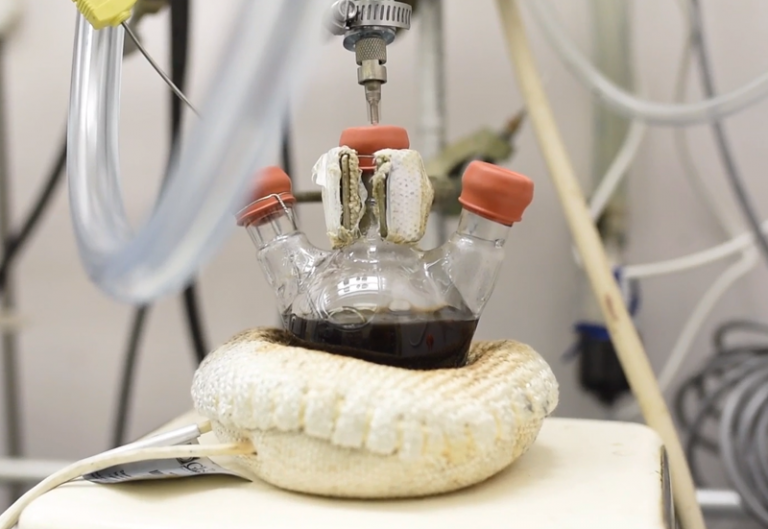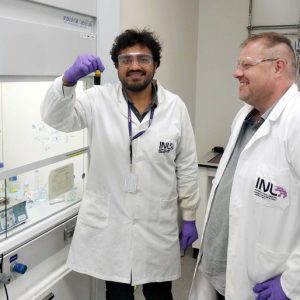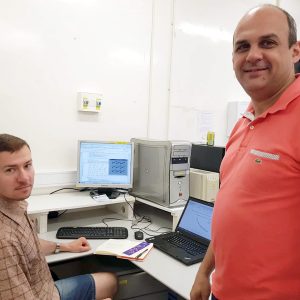“The technology will provide robust base to ongoing efforts in thermoelectrics for ZT improvement” according to its Principal Investigators.
With the intent to promote and finance short-term exploratory scientific projects, a FCT funded call opened in 2017. Targeting strategic areas of the program, 14 projects were awarded funding in 2018.
This month, we spoke with the principal investigators of UT-BORN-PT, a project that proposes an “energy harvesting device” aiming at enhancing existing technologies for heat/power recovery and conversion, with many practical usability applications.
Yury Kolenko, from the International Iberian Nanotechnology Laboratory (INL), and Brian Korgel, from The University of Texas at Austin, who lead this project, talked to us about the work being conducted in Portugal and in Austin and future prospects for the market.
The UT-BORN-PT exploratory research project proposes an approach for creating new high-zT thermoelectrics based on self-organized Binary Nanocrystal superlatices. Can you provide us some insight on this method? How does the technology work?
Self-organized binary nanocrystal superlatices (BNSLs) based on semiconducting colloidal nanocrystals is of great significance in thin-film and flexible thermoelectrics, both from a fundamental and applications perspective. In recent years, the prevailing need for facile fabrication which is solution-processable, and transport property optimization for high thermoelectric figure-of-merit, has driven the development of colloidal quantum dots (QDs) in which electrical and thermal transport can be readily modulated by dimensional constraints via quantum confinement and coupling between the nanocrystals. The chalcogenides monodisperse nanocrystals proposed in this project enable unique combination of transport properties with proximal interaction, ligand engineering and nanostructuring in nanocrystal ensembles. This will lead to decoupling of phonon and electron transport parameter and unprecedented enhancement in TE figure-of-merit for practical applicability in thin film thermoelectrics.

Clean energy sources, energy recovery and conversion are topics addressed in many current strategic agendas at an international level. Who would you consider to be the main beneficiaries of the method you are proposing? And what are the possible applications for the market?
Thermoelectric generators (TEGs) interconverts heat and electrical energy, and are energy recovery and conversion devices with enormous potential to harvest the dissipated heat from power plants, automotive engines, housing heating systems, and even electronic devices for micro-power generation applications. The synthesized BNSLs based thermoelectric materials will assist and promote the development of next generation of thermoelectrics, and concurrently will provide fundamental breakthrough for simple, scalable and low-cost processing of high performance TEGs. The significant improvement of the heat to electricity conversion factor ZT is expected to result from the proposed program, which will substantially improve the conversion efficiency. This will provide a long-term solution to the global energy recovery through utilizing huge amount of available waste energy. The proposed energy harvesting device finds practical usability for applications like automotive, industrial exhaust, wearable electronics, chilling of electronic microdevices, medical body implants, remote sensing etc.
This project involves a collaborative team of researchers from the University of Minho, INL and The University of Austin a Texas. Can you tell us more about the complementarity of skills and backgrounds the project has assembled?
The design and development of unconventional thermoelectrics requires interdisciplinary research, majorly in domains of chemistry, materials and modelling, which is well undertaken by synergistic efforts from the collaborativeteam of researchers from the University of Minho, INL and the University of Austin, Texas. The internationally recognised expertise and state-of-the-art research facilities seek to promote and disseminate knowledge in complementary areas of advanced thermoelectrics by comprehensively covering all aspect (synthesis, self-assembly, simulations, transport measurements, characterization and dissemination) altogether.
The exploratory research projects have a short duration (12 months). What is the expected time-to-market of such an innovative technology? What is the planned roadmap to move this technology forward?
The proof of concept for the synthesized BNSLs based TEGs is the key deliverable of the project. The technology will provide robust base to ongoing efforts in thermoelectrics for ZT improvement. The market for energy harvesting equipment was valued at $372 million in 2017 and is anticipated to grow at a CAGR of 11.4% during the forecast period. Moreover, the growing need for energy efficiency, increasing energy costs, and rising adoption of green energy sources further drives the growth. In such scenario, the adoption of power efficient proposed TEGs device with low maintenance will further supports market growth. It is anticipated that the supportive government regulations, increasing awareness, and compatibility related technological advancements will enable easy introduction of the proposed technology in prospective segments of defence, commercial, residential, food, industrial, transportation, and healthcare.




